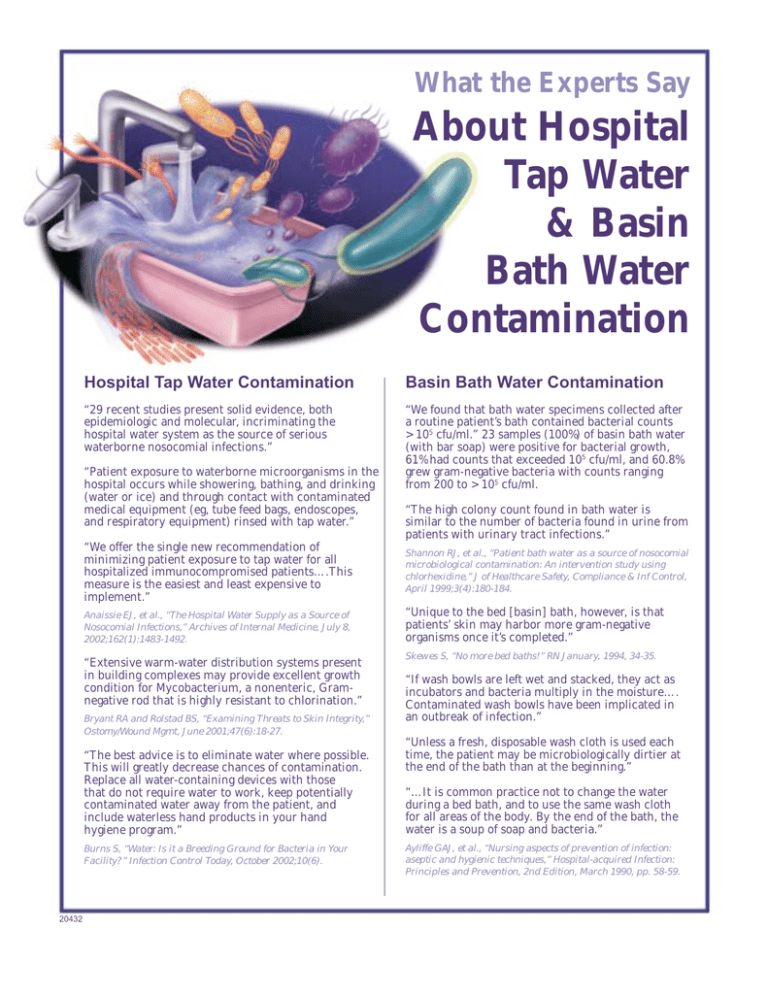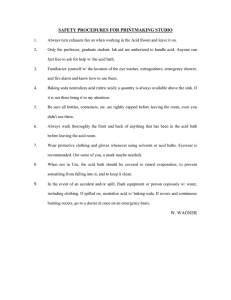Bath Water and Nosocomial Infection
advertisement

What the Experts Say About Hospital Tap Water & Basin Bath Water Contamination Hospital Tap Water Contamination Basin Bath Water Contamination “29 recent studies present solid evidence, both epidemiologic and molecular, incriminating the hospital water system as the source of serious waterborne nosocomial infections.” “We found that bath water specimens collected after a routine patient’s bath contained bacterial counts > 105 cfu/ml.” 23 samples (100%) of basin bath water (with bar soap) were positive for bacterial growth, 61% had counts that exceeded 105 cfu/ml, and 60.8% grew gram-negative bacteria with counts ranging from 200 to > 105 cfu/ml. “Patient exposure to waterborne microorganisms in the hospital occurs while showering, bathing, and drinking (water or ice) and through contact with contaminated medical equipment (eg, tube feed bags, endoscopes, and respiratory equipment) rinsed with tap water.” “We offer the single new recommendation of minimizing patient exposure to tap water for all hospitalized immunocompromised patients….This measure is the easiest and least expensive to implement.” Shannon RJ, et al., “Patient bath water as a source of nosocomial microbiological contamination: An intervention study using chlorhexidine,” J of Healthcare Safety, Compliance & Inf Control, April 1999;3(4):180-184. Anaissie EJ, et al., “The Hospital Water Supply as a Source of Nosocomial Infections,” Archives of Internal Medicine, July 8, 2002;162(1):1483-1492. “Unique to the bed [basin] bath, however, is that patients’ skin may harbor more gram-negative organisms once it’s completed.” “Extensive warm-water distribution systems present in building complexes may provide excellent growth condition for Mycobacterium, a nonenteric, Gramnegative rod that is highly resistant to chlorination.” Bryant RA and Rolstad BS, “Examining Threats to Skin Integrity,” Ostomy/Wound Mgmt, June 2001;47(6):18-27. “The best advice is to eliminate water where possible. This will greatly decrease chances of contamination. Replace all water-containing devices with those that do not require water to work, keep potentially contaminated water away from the patient, and include waterless hand products in your hand hygiene program.” Burns S, “Water: Is it a Breeding Ground for Bacteria in Your Facility?” Infection Control Today, October 2002;10(6). 20432 “The high colony count found in bath water is similar to the number of bacteria found in urine from patients with urinary tract infections.” Skewes S, “No more bed baths!” RN January, 1994, 34-35. “If wash bowls are left wet and stacked, they act as incubators and bacteria multiply in the moisture…. Contaminated wash bowls have been implicated in an outbreak of infection.” “Unless a fresh, disposable wash cloth is used each time, the patient may be microbiologically dirtier at the end of the bath than at the beginning.” “…It is common practice not to change the water during a bed bath, and to use the same wash cloth for all areas of the body. By the end of the bath, the water is a soup of soap and bacteria.” Ayliffe GAJ, et al., “Nursing aspects of prevention of infection: aseptic and hygienic techniques,” Hospital-acquired Infection: Principles and Prevention, 2nd Edition, March 1990, pp. 58-59.


